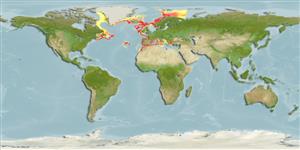Common names from other countries
Environment: milieu / climate zone / depth range / distribution range
Ecologia
marinhas demersal; não migratória; intervalo de profundidade 150 - 1000 m (Ref. 54594), usually 350 - 500 m (Ref. 54594). Temperate; 79°N - 29°N, 65°W - 44°E (Ref. 54594)
Northeast Atlantic: Southwestern Barents Sea, sometimes north to Spitsbergen, southeastern Greenland, southern coast of Iceland, around the British Isles and south to Morocco and into the western Mediterranean. Northwest Atlantic: Newfoundland.
Comprimento de primeira maturação / Tamanho / Peso / Idade
Maturity: Lm 86.5 range ? - 88 cm
Max length : 155 cm TL macho/indeterminado; (Ref. 1371); peso máx. publicado: 30.0 kg (Ref. 35388); idade máx. registrada: 20 anos (Ref. 1371)
Espinhos dorsais (total) : 0; Espinhos anais: 0; Raios anais : 70 - 81. Lower jaw longer than upper jaw; barbel shorter than eye diameter. Back gray-brown, grading to white ventrally. Posterior portions of vertical fins dark with pale margins.
Found mostly from 350-500 m depth on muddy bottoms. Feed on crustaceans and fish (flatfishes, gobies, rocklings) (Ref. 1371).
Ciclo de vida ou comportamento de acasalamento
Maturities | Reprodução | Spawnings | Egg(s) | Fecundities | Larvas
Cohen, D.M., T. Inada, T. Iwamoto and N. Scialabba, 1990. FAO species catalogue. Vol. 10. Gadiform fishes of the world (Order Gadiformes). An annotated and illustrated catalogue of cods, hakes, grenadiers and other gadiform fishes known to date. FAO Fish. Synop. 125(10). Rome: FAO. 442 p. (Ref. 1371)
Status na Lista Vermelha da UICN (Ref. 130435)
Can't connect to MySQL database (fbapp). Errorcode: Too many connections
